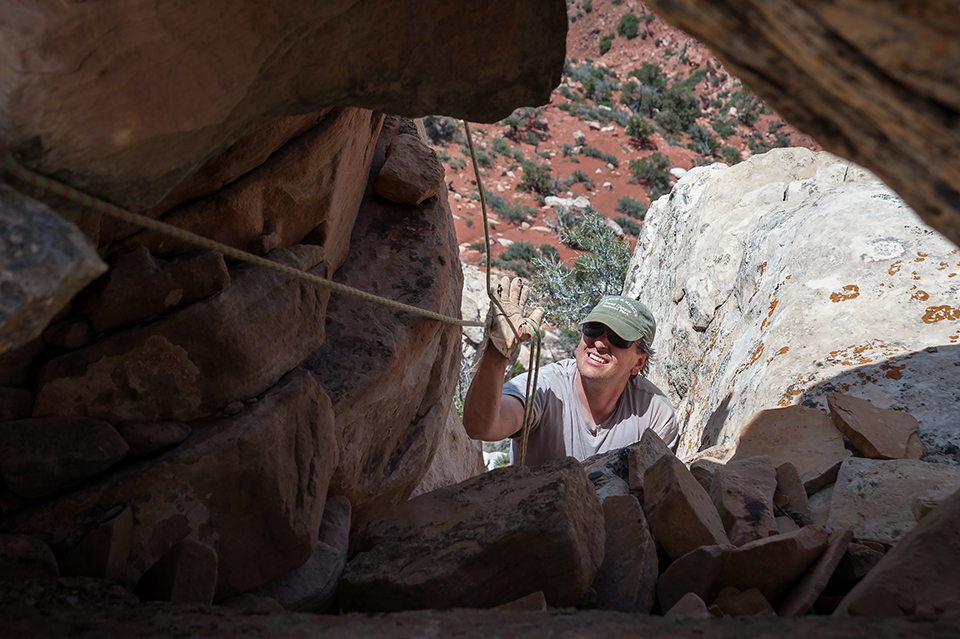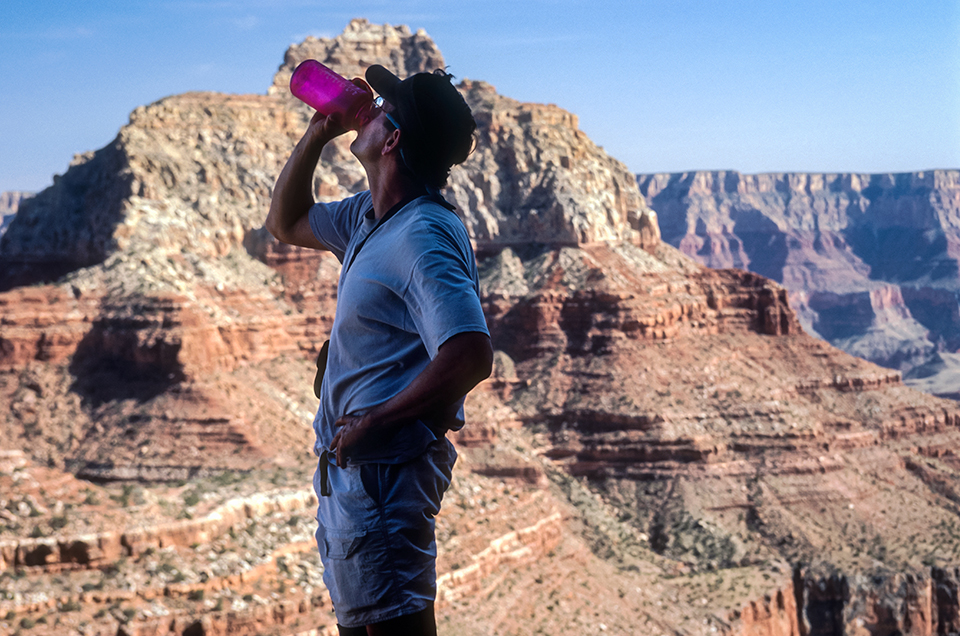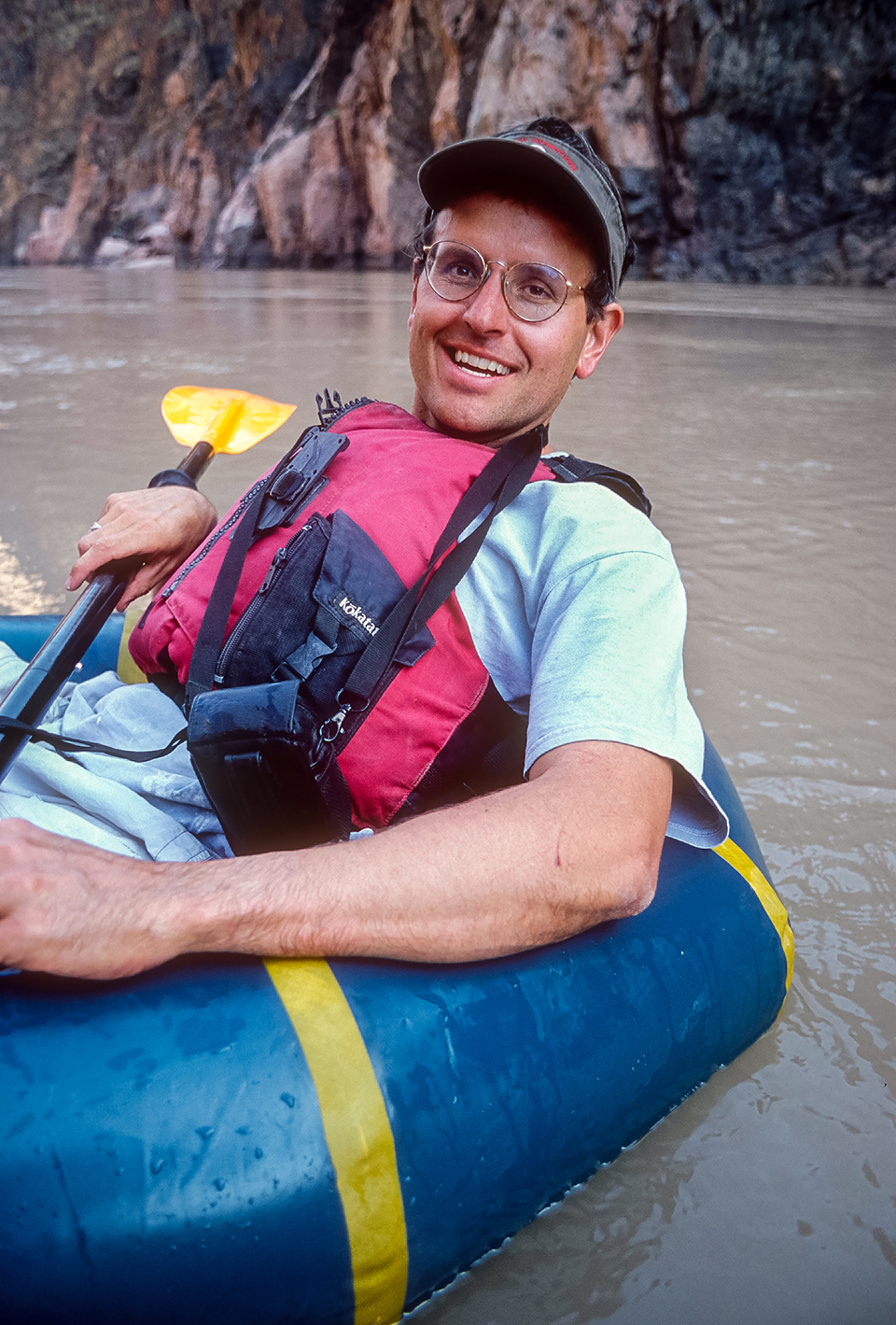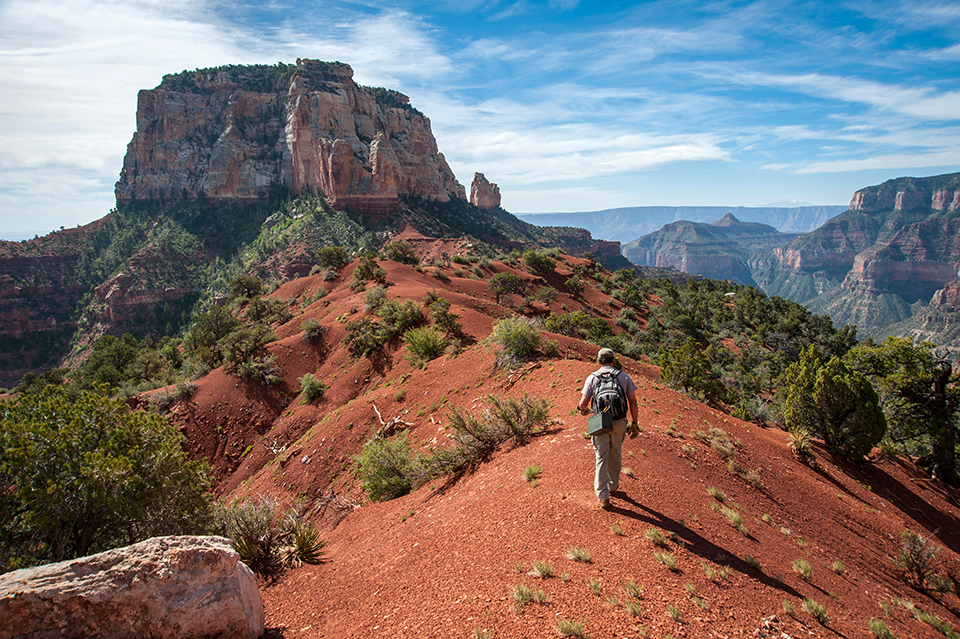When Tom Myers was in the final months of an internal medicine internship at St. Joseph’s Hospital in Phoenix in the late 1980s, he feared he’d made a terrible mistake: Despite all he had endured to get through medical school, he’d become convinced he was in the wrong line of work.
“I was one of the least happy guys in my class,” Myers recalls. He felt disenchanted with the medical system and worried he didn’t have what it took to be a good doctor. And he felt out of place in the urban hospital setting, where he spent long days in windowless rooms with fluorescent lights.
In short, he much preferred being at the Grand Canyon.
Myers informed the director of the program that he planned to abandon the profession. The director was astounded that someone would give up a prestigious and lucrative career before it had even started. “And what the heck are you going to do instead?” the director asked.
“I think I want to be an interpretive ranger at Grand Canyon,” Myers replied. “I want to educate park visitors and tell stories about the place.” At that, the director was even more dumbfounded.
But the natural wonder and its surroundings had been part of Myers’ life since childhood. He’d grown up in Flagstaff and been hiking in the Canyon since his teens, and before going to medical school at the University of Arizona in Tucson, he’d earned a bachelor’s degree in history from Flagstaff’s Northern Arizona University. And as he worked long shifts at the Phoenix hospital, he realized he was far more passionate about exploring remote, spectacular places than about becoming a wealthy doctor who drove an expensive car.
As soon as his internship ended, Myers, his wife, Becky, and their baby daughter, Brittany, moved to Flagstaff. And fortunately for the young family, before Myers hung up his stethoscope, he got a life-changing phone call.
Myers had inquired about a job at a clinic in Williams, and his interest had been passed along to Grand Canyon National Park, which needed a doctor. Myers was unaware the park even had a medical clinic, but after an interview there, in 1990, he took a job as one of two physicians serving Canyon visitors and residents — a constantly shifting population of as many as 30,000 people. As an old-school country doctor, he treated patients in one of the most environmentally hazardous landscapes in the United States. And practicing emergency medicine in what Myers calls the “greatest heat lab on Earth” suited him well.

Since then, Myers has become an authority on Canyon wilderness medicine and advised the park’s growing search and rescue program. And having a job where he’s “paid in sunsets” has allowed him to indulge his other passions of hiking, history and storytelling, making him a de facto interpretive ranger.
Myers is the co-author, with Michael Ghiglieri, of the 2001 book Over the Edge: Death in Grand Canyon, which has sold nearly 400,000 copies and is considered a backcountry bible for anyone venturing below the rim. With another co-author, photographer Elias Butler, he wrote the 2007 book Grand Obsession, the definitive biography of prolific Canyon hiker Harvey Butchart. And Myers’ memoir, The Grandest Trek — to be released this spring by his and Ghiglieri’s publishing company, Puma Press — chronicles a 600-mile, end-to-end hike of the Canyon that Myers did with his son, Weston.
“It’s almost impossible to go anywhere or read anything connected to Grand Canyon without following a trail cut by Tom Myers,” says author Kevin Fedarko, who says he benefited from Myers’ expertise in writing his own bestselling Canyon books, The Emerald Mile and A Walk in the Park. “Having such extensive medical knowledge of Grand Canyon is impressive on its own,” he adds. “But Tom also possesses a deep and historic understanding of the place — and it’s all in one brain. There is nobody else like him. He is Mr. Grand Canyon.”
But Fedarko and others in the Canyon community say what drives Myers isn’t ego or a desire for notoriety. It’s his unbridled enthusiasm for the Canyon — a love that’s helped him heal from a difficult childhood. For this doctor, the natural wonder is powerful medicine.
Myers was born in Wisconsin as the seventh of nine children. His father was a physician, too, but also an unhappy and frequently angry man who was never around, he says. When Myers was 9, his parents divorced, and his mother soon moved the family to Flagstaff. As a single parent receiving no financial support from her ex-husband, Myers’ mother worked low-paying service jobs and received food stamps to raise nine kids on her own.
Although it was a tough childhood, there were good times — and some of the best were camping trips at the Canyon. The family mostly stayed in the park’s developed areas and took short day hikes, but by the time Myers was 19, he was venturing below the rim on backpacking trips. “I thought Grand Canyon was the coolest place on the planet to go hiking,” he recalls. “It captured my whole being.”
Myers’ brothers weren’t eager to heft heavy packs in rugged terrain, but Myers couldn’t get enough of it. When he was in college and working multiple jobs, he devoured Canyon guidebooks and embarked on ambitious day hikes there whenever he had a day off.
The position at Grand Canyon Clinic offered easy access to the natural wonder, but getting to live in the park wasn’t the only motivation. “I took the job because of Jim Wurgler,” he says of the clinic’s longtime supervising physician. “I wanted to learn everything I could from him. He was like the father I never had.”
Wurgler, who died in 2019 at age 85, specialized in rural and emergency medicine, having served as a U.S. Army physician during the Vietnam War and then at Yosemite and Grand Canyon national parks. He mentored Myers in treating the medical issues that turned up at the clinic 24 hours a day, seven days a week. The two alternated being on call at night to respond to a constant stream of emergencies.

In his first few months, Myers treated a gunshot wound to the chest and stabilized a man who’d suffered a head injury while riding his bicycle at night. And there were plenty of backcountry injuries, too. Serious cases were transferred to Flagstaff Medical Center after Myers and Wurgler stabilized the patients. But if bad weather made roads too treacherous for an ambulance, the Canyon doctors had to manage on their own.
Myers and Becky had two more children, Alexandra and Weston, during the nearly 10 years they lived at the park. Becky recalls that their home served as a makeshift doctor’s office, with the Canyon’s residents often stopping by to consult Myers about their ailments. “Tom did minor surgeries at our dining room table,” she says with a laugh.
Myers also prided himself on how quickly he could get to the clinic when emergency calls came in. “I would go from a dead sleep to putting my clothes on and sprinting over there in less than two minutes,” he recalls.
One of his most memorable emergencies came one evening in December 1996, during the clinic’s Christmas party. It was snowing, and a Havasupai Tribe member showed up with an infant who was near death. After being left alone for several hours in a home without heat, the baby was severely hypothermic. “His breathing was shallow, his blood sugar was very low, and his core temperature had dropped to 89 degrees,” Myers recalls. “I was sweating bullets.”
The 4.5-pound infant was too small for standard lifesaving measures such as CPR. And his veins were so tiny, it seemed there was no way to administer an IV mixture of warm saline and glucose. But Myers remembered a rarely used emergency procedure he’d learned a few years earlier, in which the IV needle was placed in the shin bone, allowing the liquid to travel through the bone marrow of the shin. Myers managed to get the needle into the tiny bone, and the baby’s life was saved. The infant was then stable enough to be flown by helicopter to a Phoenix hospital, where he recovered for a month.
Another case that year was less fortunate: A 10-year-old boy died from heatstroke while hiking with his family on the waterless South Kaibab Trail, and two other family members suffered heat exhaustion. It was the hottest day of the year, and the family had disregarded warnings from a ranger that they should abort their trek.
“Kids are often victims of their parents’ poor decisions in Grand Canyon,” Myers says. And he cites the boy’s death as his motivation for compiling data on fatalities in the park — a project that eventually became Over the Edge: Death in Grand Canyon. “I wanted to share information that would save lives,” he says.

During many long nights at the clinic, Myers pored over years of park fatality reports. He then teamed with Ghiglieri, a river guide and author, to write the 500-plus-page book, which lists every known death in the park but also offers guidance on how backcountry visitors can avoid becoming a statistic themselves. Over the Edge won the National Outdoor Book Awards’ “Classic” category in 2016, and it’s now in its 38th printing.
In 1999, two years before Over the Edge came out, Myers and Becky decided to move the family back to Flagstaff. The 24/7 work schedule was exciting but also exhausting, and Myers wanted to spend more time with his three children. But he continued to work part time at Grand Canyon Clinic, and he also dived into a new book project: a biography that gave him an excellent excuse to log more time below the rim.
The late Harvey Butchart, a guidebook author and NAU math professor, is considered the founding father of off-trail hiking in the Canyon, pioneering routes throughout the park from the 1950s to the late ’80s. Myers had collected history on Butchart for years and was eager to publish a book after Butchart’s death in 2002. But to write a proper biography of the eccentric professor, Myers and his co-author, Butler, decided they first needed to retrace Butchart’s steps on perilous Canyon routes. (The resulting biography also won a National Outdoor Book Award, in 2008.)
What Butler soon discovered was that, despite having encyclopedic knowledge on how people had died in the Canyon, his co-author was prone to pushing the envelope during his own hikes.
One time, Butler and Myers were doing one of Butchart’s favorite hikes, a trek that dropped off Great Thumb Mesa. They reached the crux of the route on the Redwall Formation and discovered they would need to climb down a 30- to 40-foot cliff without ropes. Slipping would have meant falling hundreds of feet into the abyss. It was the kind of place where Butler would normally have turned back, but such a thought never occurred to Myers.
“Tom wasn’t going to be thrown off by a little bit of danger,” Butler recalls. “He just worked his way down the cliff and showed me how it could be done. In the end, it was not that big of a deal.” Butler adds that Myers’ derring-do helped him expand his own backcountry capabilities. “Tom has a way of putting himself aside so the Canyon lover in him can emerge,” he says. “And he acts on this love without restraint, moving fearlessly and relentlessly through the backcountry.”

Myers, now 61, has passed his love for Canyon exploration on to Weston, as reflected in his forthcoming book, The Grandest Trek, about their 600-mile journey through the natural wonder. The pair started their hike in 2008, when Weston was 13 and in the throes of depression. Supporting his son’s mental health was Myers’ motivation, and the pair completed the hike over 17 trips, breaking the Canyon into sections that could be done during breaks from work and school. In 2016, they completed the journey, making Weston, who was 20 at the time, the youngest person known to have hiked the Canyon from end to end. As of 2024, only 57 people have completed that hike since records started being kept in the 1970s.
The Canyon worked its magic on Weston, just as it had on his father as a young man. Myers writes in his book: “The Canyon changed [Weston’s] attitude from despondency and disdain to eager engagement and hope for the future. Insecurity was replaced with self-confidence. Self-doubt with self-worth. Fear with courage. And indifference with love.” And by spending quality time with his son in the Canyon, Myers was able to heal his own hurt by being the kind of father he’d never had.
Today, Weston is 29 and completing his fourth year of medical school at the UA. And, like his father, he often steals away whenever he can find free time to knock off another challenging route deep in the Canyon. Myers usually can’t resist tagging along.
Myers continues to work part time at Grand Canyon Clinic, now operated by North Country HealthCare as an urgent care facility without extended hours. He also helps train the park’s emergency medical staff in the latest wilderness medicine protocols and procedures, especially those for treating heat illness.
“Every time Tom gives a lecture, I learn something new,” says Meghan Smith, the longtime supervisor for the Canyon’s Preventive Search and Rescue program. Smith adds that Myers’ institutional knowledge has made him an invaluable resource for the next generation of Canyon medical staff. “Tom always talks about how lucky he was to be mentored by Dr. Wurgler,” she says. “Well, Tom is our Dr. Wurgler.”
Butler saw Myers’ dedication to his work firsthand in the early 2000s. “We were headed out for a hike, and Tom wanted to stop on the way and visit this kid,” he recalls. They pulled up to Supai Camp, a cluster of houses in the park where Havasupai tribal members live, and Myers approached a young boy who was playing outside. “Hey, how are you?” he said to the boy. “It’s Dr. Myers. Do you remember me?”
The boy wasn’t so sure about the friendly stranger but smiled politely while Myers did a visual inspection of the boy’s legs and overall health. As they walked back to the car, Myers told Butler that he’d saved the boy’s life years earlier, on a cold winter night in 1996. He just wanted to make sure the kid with a small scar on his shin was doing OK.
Tom Myers had, indeed, chosen the right profession.

